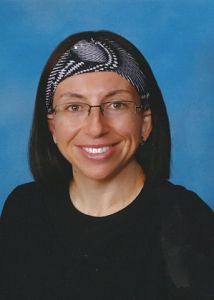Innovator
Bringing the Classroom to Life With Green Screen Technology
 As the education technology specialist at Brauser Maimonides Academy in Fort Lauderdale, FL, Hanna Shekhter heads all things tech at the K-8 Jewish day school. She works with teachers to integrate technology into their curriculum, teaches a computer class and manages IT. In addition to steering teachers toward free online tools such as Prezi and Glogster that can help them craft more dynamic presentations, she has begun working with faculty to implement green screen technology as a way to “transport students to another location or time.”
As the education technology specialist at Brauser Maimonides Academy in Fort Lauderdale, FL, Hanna Shekhter heads all things tech at the K-8 Jewish day school. She works with teachers to integrate technology into their curriculum, teaches a computer class and manages IT. In addition to steering teachers toward free online tools such as Prezi and Glogster that can help them craft more dynamic presentations, she has begun working with faculty to implement green screen technology as a way to “transport students to another location or time.”
THE Journal: How did you end up gravitating toward a movie production technique like green screen?
Hanna Shekhter: I wanted to be more creative with the iPads in our school, using iMovie, and the Green Screen by Do Ink app allows you to put either a video or an image behind the students. The fifth-grade social studies class was learning about the American Revolutionary War, so as a group project we had them do a newscast of it, written by the students and delivered with different images behind them showing a battle or the historical people. They ended up with a great interactive video. Not all kids are into history or that era, but because they were part of creating this piece of work, everyone was much more involved. Since then we’ve bought some green screen paint so we can have it up in the office all the time and constantly create these fun videos with the different grades.
THE Journal: Were you concerned about your ability to pull this off?
Shekhter: Yes. At first I thought, “I’m not a movie producer,” and this is a very “high school” thing to do, or at least something for a larger school than ours. Then I realized that with the mobile devices on hand and so many different apps available, we don’t need the expensive cameras or the lights or any of the equipment that a proper movie production studio would require. The students were able to do everything themselves. It was very hands-on for them.
THE Journal: What else have you done with it?
Shekhter: We teach a lot about Israel in our school, and some of the kids have never been, so we will put up a picture of, for example, the Western Wall, and you can superimpose students being there. It’s like a virtual field trip. The younger group really got a kick out of that. We’ve used green screen to reenact the Boston Tea Party, or to order lunch at a restaurant in a foreign language in the country of that language. It just takes the students to another place to give them a deeper understanding of what they are learning. And that’s really my goal: to use technology not for experiences that are separate from the curriculum, but to make what the students are learning more meaningful.
THE Journal: How did you end up doing this kind of work?
Shekhter: My first degree is in biomedical engineering, so a lot of coding. I also have a degree in information technology, and I always worked for software companies, but eventually I decided that while being in a cubicle with a bunch of other engineers is great, I wanted something that would have more meaning for me. I have children, and I became more interested in their education and making sure they were in tune with technology. When I started working in classrooms with young students, I realized the importance of reaching kids at an early age to teach the skills that using technology provides for a lifetime.
THE Journal: Aren’t kids using technology at an early age anyway?
Shekhter: Well, one of the things that makes me nervous is the fact that they use it more for social reasons and entertainment. My focus has been to teach kids and teachers and parents how this can be used as a powerful educational tool. I try to help our parent body understand that at your house these might be toys, but here we actually do wonderful things with them and they have great value as learning tools.
THE Journal: What is the most rewarding aspect of what you’re doing now?
Shekhter: Definitely my interactions with the students. When they come to my class or I go to theirs to work with their teacher on the technology, they are very excited, and it’s not always easy to get students excited about learning. Then, once I can get them past the “look at how fun this is” stage, I know there is going to be more meaning for them in what they learn — and their excitement just pushes me to keep looking for better and better things.
| You can see more great feature articles in the latest issue of our monthly digital edition. |
About the Author
Dan Gordon is a freelance writer based in Agoura Hills, CA.